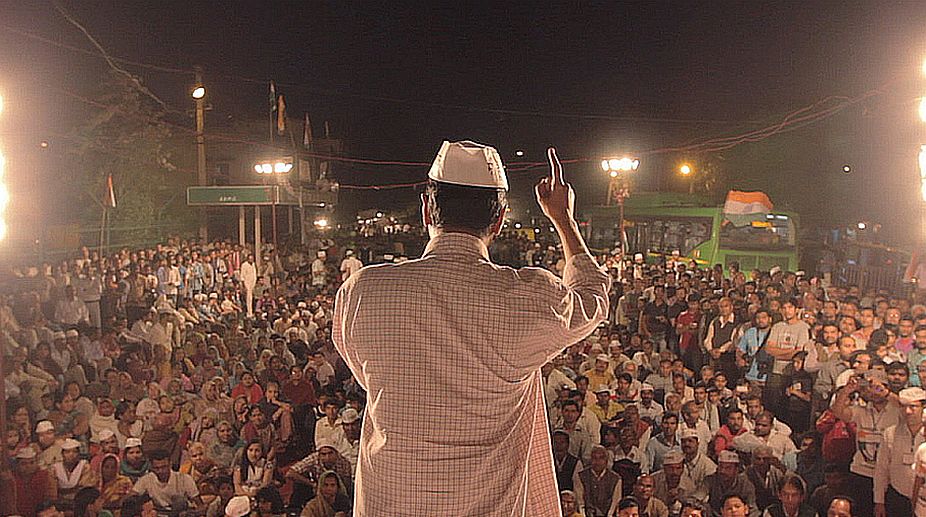AAP claims rising drug abuse in Delhi, demands action
The AAP on Monday claimed that drug abuse is on the rise in the national capital and demanded action from Chief Minister Rekha Gupta on the same lines as Punjab.

A still from Insignificant Man (Photo credits: YouTube)
Don’t hunt an animal that you can’t kill, his detractors would say. He, however, went for the hunt and killed the animal!
The new renegade on the Indian political landscape, Arvind Kejriwal, surprised everybody when he emerged the winner in his first battle of the ballot. A documentary film — An Insignificant Man — captures maverick Kejriwal’s journey from nobody to somebody. The nearly 95-minute political thriller is extracted from hundreds of hours of real-life videos.
Advertisement
Entering politics on the anti-corruption plank, Kejriwal’s charisma to instantly connect with the people is what the film delves into. The film gives us an idea how his slogan of Swaraj (people’s government) and corruption-free governance are lapped up by the lower strata in the national capital. Also, it underlines the power of the common man in a democracy.
Advertisement
Directed by Khushboo Ranka and Vinay Shukla, ‘An Insignificant Man’ makes the viewers to believe that change is possible and one only needs to stand up firmly against the system. The film has already been released in some parts of the world and is scheduled to be released on November 17 in India.
Former tax official, Kejriwal first joined the Anna Hazare’s Jan Lokpal Bill movement. With a handful of like-minded social activists, Kejriwal tests the waters by going to the masses with the agenda to let people have say in the governance and boot out the corrupt. Buoyed by the response, Kejriwal and his close aides form a political outfit — Aam Aadmi Party (AAP) — and decide to fight the Delhi Assembly elections in 2013. The decision is taken after a referendum in the congested bylanes where the Delhi’s marginalised population live.
The activism of Santosh Koli, a resilient Kejriwal supporter, who died after getting injured in an accident, also catches the viewer’s attention. The vociferous and devoted activist is the only ‘martyr’ shown in the film whose accident occurred after she was threatened by the people she had become a threat to. Santosh was running a campaign and filing RTI applications to stop pilferage of subsidised grains meant for the poor.
AAP banked on the funding from the crowd to meet the election expenses when, as a tradition, money flowed in the reverse direction during polls. Crowdfunding to match the established political parties with deep pockets looked a foolish idea, but Kejriwal made it work. Kejriwal and members of his core team comprising Yogendra Yadav, Kumar Vishwas, Sanjay Singh, etc., go to the masses and make them take pledge not to accept favours in cash or kind from politicians in lieu of their vote.
The AAP leaders weave the election campaign around costly water and electricity in Delhi. The party promises to reduce the electricity bills to half and provide 700 litres of free water if it is voted to power. This strikes the nerves of the Delhites as people in hordes come to the party leaders with complaints of overcharging and exorbitant bills.
In the run up to the December 2013 polls, the party faces intimidation, violence, attempts to buy its supporters, along with the ‘suspicious’ accidental death of Santosh Koli, its candidate from Seemapuri.
Kejriwal himself takes the biggest challenge and files nomination against the then Delhi Chief Minister Sheila Dikshit from the Gol Market seat.
On the result day, 8 December 2013, Kejriwal’s AAP emerges as the second largest party with 28 seats even as no single party has the mandate to form the government. The BJP emerges as the single largest party with 31 seats. And, Kejriwal is among the winners!
With eight seats, Congress offers unconditional support to AAP and Kejriwal announces a public referendum to decide whether or not to form the government with Congress’ support. Going by the public sentiment, Kejriwal stakes claim to form the government and takes oath as Delhi Chief Minister at Ramlila Maidan in the presence of thousands of supporters. This is the first drift from the tradition of organising the ceremony at Raj Bhawan.
The film ends even as the bigger success to AAP came in the snap polls about a year later (February 2015) when the AAP won 67 of the 70 seats, an unprecedented mandate.
The film runs text on some developments, including the expulsion of Yogendra Yadav from the party. When director Khushboo Ranka was asked why the film couldn’t be stretched at least till the landslide victory for the AAP, she said: “The project was wrapped up before all this happened.”
Only the film has ended, Kejriwal and his style of politics live on. How successful they will be, only time will tell.
Advertisement